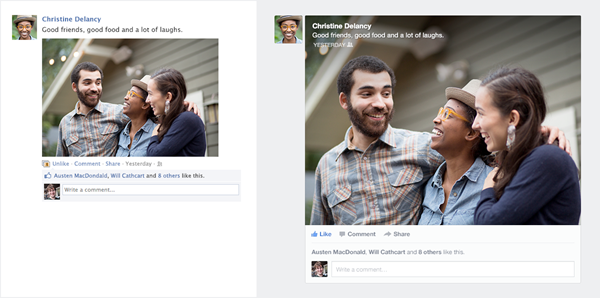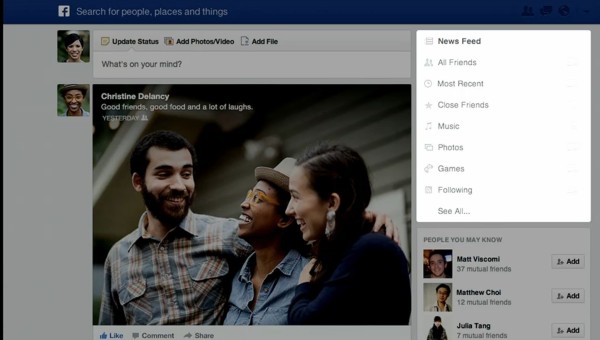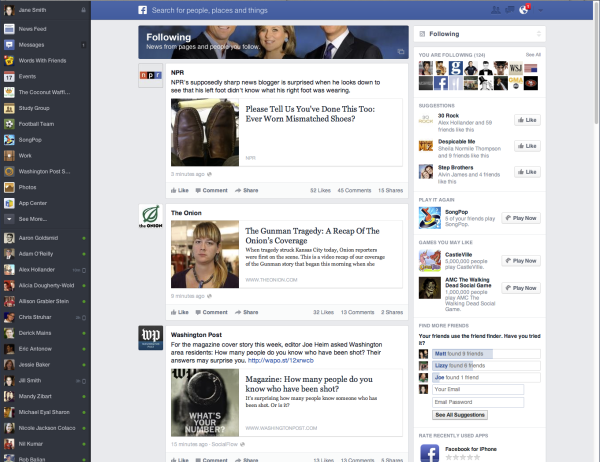Facebook News Feed Evolving Into “The Best Personalized Newspaper”
While most people don’t think of Facebook as the equivalent of a “personalized newspaper,” that’s how many inside Facebook think about News Feed. And that was the metaphor repeatedly used throughout the presentation today. But more on that later. Here’s our related coverage from today: How To Get The New Facebook News Feed Power To […]
While most people don’t think of Facebook as the equivalent of a “personalized newspaper,” that’s how many inside Facebook think about News Feed. And that was the metaphor repeatedly used throughout the presentation today. But more on that later.
Here’s our related coverage from today:
- How To Get The New Facebook News Feed
- Power To Separate Feeds: A Look At The Filtering Inside The New Facebook News Feed
- Facebook’s New News Feed: The Before & After Look
And now, an overview of what Facebook announced today. In a nutshell, here are the changes:
- Less clutter on the homepage
- Consistent design across devices (PC, mobile, tablet)
- Richer, larger, more “immersive” images
- Global navigation across the entire site
- Clustering of shared content (and content suggestions)
- Separation of feeds for greater user control (see related article)
The rollout is global, but it will be quite slow, according to Facebook, as the company gathers user feedback on the changes.
All of the images have been made significantly larger. When Facebook News Feed began it was mostly text. Over time, it has evolved into mainly photo and video sharing. The enlargement of the images is a recognition of that as well as a bid for deeper engagement.
The Facebook-provided-screens below offer a comparison of the scale differences between the old and new image sizes.
In order to give users more control over their feeds, Facebook (as anticipated) has separated them into tabs that appear in the upper right. Here are the tabs:
- All Friends
- Images
- Following
- Music
- Most Recent Feed
- Close Friends – The same
- Games
Any Pages or publisher content being followed will appear under “following.” In general, the tabs or sections give people more control over what they’re seeing and the ability to sort or filter information that’s important to them — reducing some of the “noise” in the feed. ‘
Greg Finn has written about this in more detail.
If a group of friends has shared a video, article or image that will be clustered together in your feed in one place. You’ll be able to mouse over the photos of friends and see what they wrote or click and see the entire conversation about the image or video. There will also be content suggestions packaged up for you based on your interests and what your friends shared.
Overall, I think these changes are positive. We don’t know how this will impact Facebook Ads other than to assume that the “bigger more immersive treatment” of everything will apply to them. That was the suggestion during Q&A. However, there was no discussion of Ads during the formal presentation.
Facebook users seem to always complain when changes to the site are introduced. However I don’t think there will be much complaining here; these changes seem to give users more control, make the site visually more interesting and reduce clutter.
With the newspaper allusion and metaphor I was reminded of all the personalized homepages that used to exist: Google’s personalized homepage, MyYahoo, Microsoft’s version and so on. There were seven or eight of them; each of the big sites had one. They were largely RSS readers and faded with limited use or were shuttered as in the case of the Google personalized homepage.
This is the return of that idea on some level.
The concept of a “personalized newspaper” could be pushed much further by Facebook in interesting ways, which could add even greater engagement and overall utility to the site.
I confirmed with Facebook that there would be no impact from any of these changes on Graph Search, which is rolling out in parallel.
Opinions expressed in this article are those of the guest author and not necessarily MarTech. Staff authors are listed here.
Related stories



